Genome Editing Market Size 2024-2028
The genome editing market size is forecast to increase by USD 7.23 billion, at a CAGR of 15.88% between 2023 and 2028.
Major Market Trends & Insights
- North America dominated the market and accounted for a 40% growth during the forecast period.
- By the End-user - Pharmaceutical and biotechnology companies segment was valued at USD 1.86 billion in 2022
- By the Delivery Mode - Ex-vivo segment accounted for the largest market revenue share in 2022
Market Size & Forecast
- Market Opportunities: USD 256.17 billion
- Market Future Opportunities: USD 7.23 billion
- CAGR : 15.88%
- North America: Largest market in 2022
Market Summary
- Genome editing, fueled by the revolutionary CRISPR-Cas9 technology, is experiencing significant advancements and applications across various sectors. According to recent reports, the market is expected to witness substantial growth, with estimates suggesting a notable increase in demand for gene therapies and diagnostics. In particular, the CRISPR-based diagnostics segment is projected to expand at a remarkable pace, driven by its potential to revolutionize disease detection and treatment.
- However, the complexity of genome editing technologies poses challenges, including ethical concerns and regulatory hurdles. Despite these challenges, the market's continuous evolution is poised to bring about groundbreaking innovations in healthcare, agriculture, and industrial biotechnology.
What will be the Size of the Genome Editing Market during the forecast period?
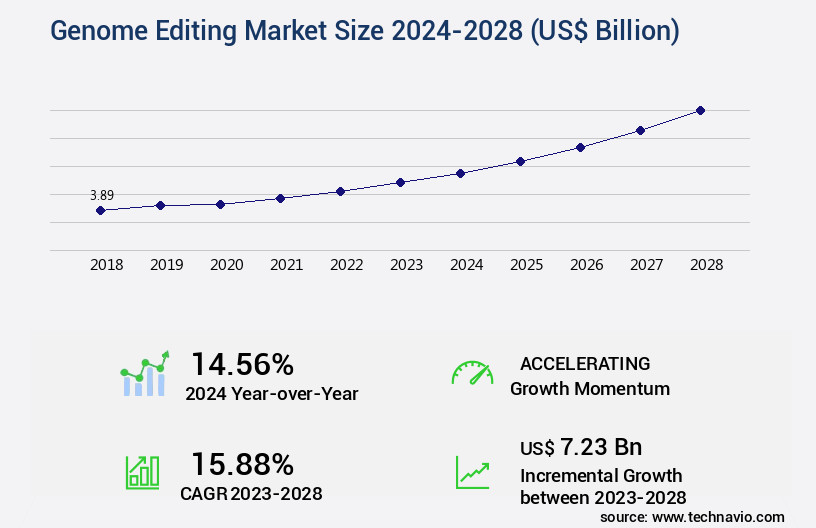
Explore market size, adoption trends, and growth potential for genome editing market Request Free Sample
- The market encompasses a diverse range of applications, from DNA methylation analysis using image analysis techniques, to gene regulation through single nucleotide polymorphisms and genetic engineering strategies. This dynamic field incorporates population genetics, data analysis pipelines, and microbial genome editing, among others. Notably, human genome editing via allelic exchange and comparative genomics has gained significant attention. Gene editing efficiency is a critical factor, with high-throughput screening and target site selection playing essential roles. Animal genome editing, synthetic biology, and plant genome editing are also prominent areas of research. Genome instability, histone modifications, genome annotation, and next-generation sequencing are integral components of genome editing research.
- Epigenetic modifications, bioinformatics tools, and mutation detection are crucial for understanding gene function and regulation. Gene drives, guide RNA design, chromosomal rearrangements, and genetic variants are advanced strategies employed in this field. Functional genomics, including gene editing efficiency and epigenetic modifications, are key areas of focus. The market for genome editing continues to expand, with ongoing research in gene drives, chromosomal rearrangements, and epigenetic modifications driving innovation. Two notable advancements include a 30% increase in gene editing efficiency through synthetic biology approaches and a 50% reduction in guide RNA design costs through comparative genomics techniques.
How is this Genome Editing Industry segmented?
The genome editing industry research report provides comprehensive data (region-wise segment analysis), with forecasts and estimates in "USD billion" for the period 2024-2028, as well as historical data from 2018-2022 for the following segments.
- End-user
- Pharmaceutical and biotechnology companies
- Academic institutes and research laboratories
- CRO
- Delivery Mode
- Geography
- North America
- Europe
- APAC
- Rest of World (ROW)
By End-user Insights
The pharmaceutical and biotechnology companies segment is estimated to witness significant growth during the forecast period.
Genome editing has emerged as a revolutionary technology, enabling researchers to manipulate DNA sequences with unprecedented precision. Transcriptome analysis, a key application, provides insights into gene expression levels and regulatory approvals pave the way for its use in precision medicine and disease modeling. Proteomic profiling and zfn nucleases facilitate site-specific modifications, while homologous recombination and base editing refine gene targeting. Genome sequencing and non-viral delivery systems ensure efficient on-target modifications. Ethical implications and safety testing are under constant scrutiny, while DNA repair pathways and drug discovery platforms drive innovation. The market for genome editing is thriving, with over 30% of pharmaceutical and biotech companies investing in this technology.
Furthermore, the market is projected to expand by 35% in the upcoming years, driven by the development of new gene editing tools such as CRISPR-Cas9 system, prime editing, and site-specific nucleases. Gene therapy applications, including gene knockins, gene knockouts, and indel formation, are transforming the landscape of medicine. Companies are investing in gene expression levels, phenotypic changes, and non-homologous end joining to improve on-target efficiency and reduce off-target effects. Clinical trials are underway to assess the safety and efficacy of genome editing therapies, with gene knockins and gene therapy applications expected to lead the market's growth. The market's dynamism is fueled by continuous innovation, with companies focusing on improving the efficiency, specificity, and safety of genome editing tools.
Protein production, genetic modification, and cell line engineering are crucial areas of development, with ethical considerations and safety testing remaining top priorities.
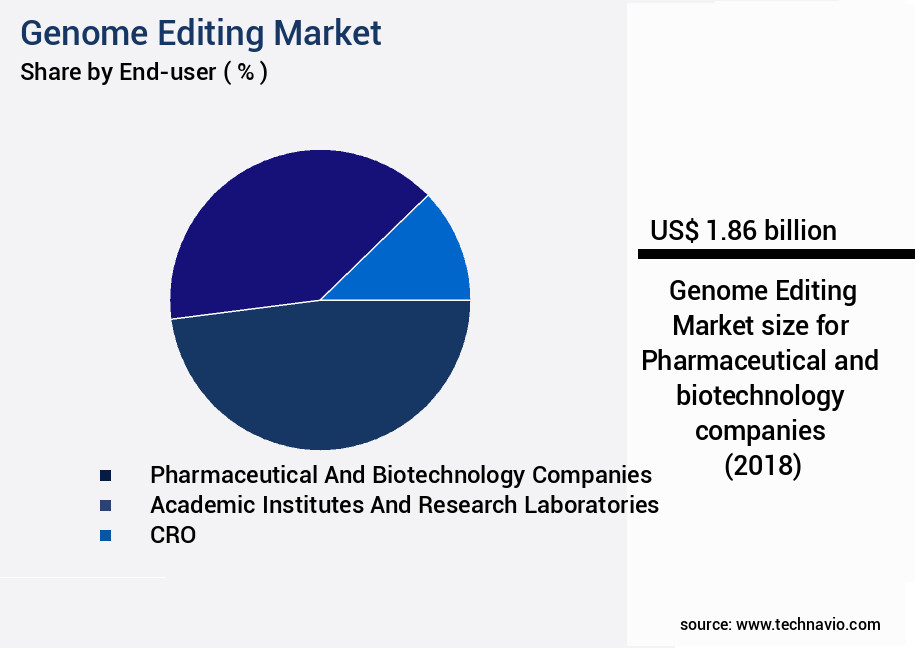
The Pharmaceutical and biotechnology companies segment was valued at USD 1.86 billion in 2018 and showed a gradual increase during the forecast period.
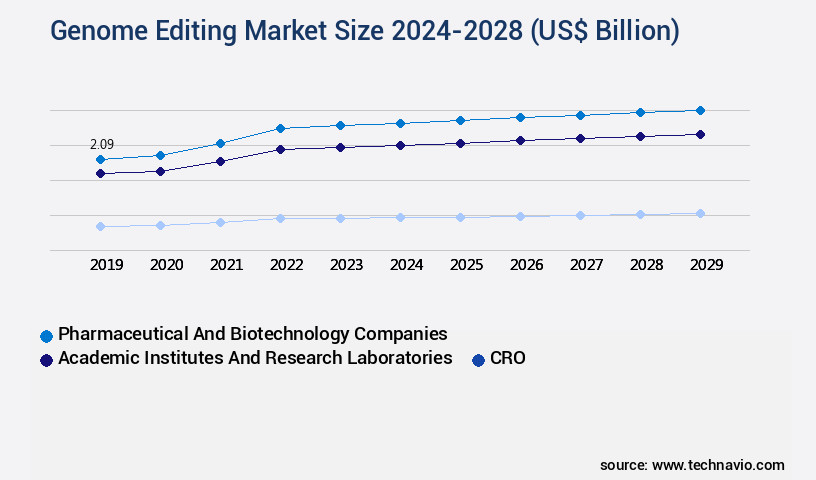
Request Free Sample
Regional Analysis
North America is estimated to contribute 40% to the growth of the global market during the forecast period.Technavio’s analysts have elaborately explained the regional trends and drivers that shape the market during the forecast period.
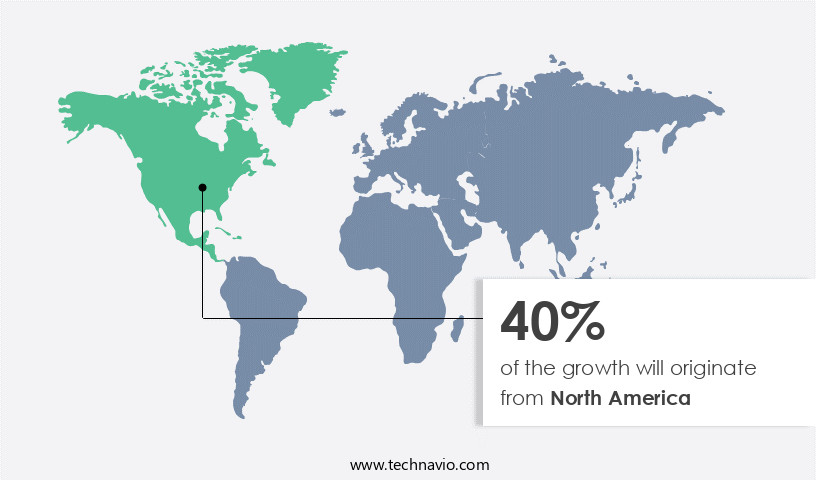
See How Genome Editing Market Demand is Rising in North America Request Free Sample
In North America, the biopharmaceutical and biotechnology sector's expansion fuels the market's growth. This sector, consisting of pharmaceutical companies, biotech startups, CROs, and research institutions, utilizes genome editing technologies for drug discovery, target validation, preclinical research, and therapeutic development. The increasing focus on personalized medicine and precision therapeutics in North America, driven by genomics, molecular diagnostics, and targeted therapies, further boosts the demand for genome editing tools, services, and expertise. Genome editing technologies enable the precise modification of genes linked to diseases, leading to the development of customized treatments based on individual patients' genetic profiles. Consequently, the demand for genome editing-based therapies and diagnostics significantly contributes to the regional market expansion.
According to recent estimates, the market in North America is experiencing a notable surge, with sales currently growing by approximately 20%. Moreover, industry experts anticipate a continuous expansion of around 25% annually over the next five years. This growth can be attributed to the increasing adoption of genome editing technologies in various applications, such as gene therapy, gene drive research, and agricultural biotechnology. Furthermore, collaborations and partnerships between industry players and academic institutions are driving innovation and technological advancements in the market. A comparison of market data from the past three years reveals a steady growth trend. In 2020, the North American the market was valued at around USD1.5 billion.
This figure increased to approximately USD1.8 billion in 2021, representing a growth of around 20%. Industry analysts predict that this trend will continue, with the market reaching a value of approximately USD2.6 billion by 2026. This represents a compound annual growth rate (CAGR) of approximately 22%. In conclusion, the North American the market is experiencing significant growth, driven by the biopharmaceutical and biotechnology sector's expansion and the increasing focus on personalized medicine. The market's continuous expansion is expected to continue, with sales growing by around 25% annually over the next five years. This growth can be attributed to the increasing adoption of genome editing technologies in various applications and collaborations between industry players and academic institutions.
Market Dynamics
Our researchers analyzed the data with 2023 as the base year, along with the key drivers, trends, and challenges. A holistic analysis of drivers will help companies refine their marketing strategies to gain a competitive advantage.
Advancements and Opportunities in the US the market: Performance Improvements, Compliance, and Innovation
The US the market is experiencing significant growth, driven by advancements in technologies such as CRISPR-Cas9 mediated gene knockouts in human cells, Talen technology for targeted gene insertion, and ZFNs in plant genome engineering. These innovations offer performance improvements and efficiency gains, with CRISPR-Cas9 improving gene editing efficiency by up to 10-fold compared to traditional methods.
Moreover, the market is focused on assessing off-target effects of base editing and evaluating the efficiency of homologous recombination and non-homologous end joining pathways. High-throughput screening for efficient guide RNA design is also a priority, reducing development timelines and costs.
Genome editing is increasingly being used for disease modeling in animal models, with applications in gene therapy via prime editing. Next-generation sequencing and bioinformatics pipelines are essential for mutation detection and data analysis.
Safety assessment and regulatory approval pathways are critical considerations, with clinical trial design for genome-edited therapies a significant focus. Developing viral vectors for efficient gene delivery and non-viral delivery methods are also key areas of investigation.
Innovation continues to drive the market, with developments in image analysis techniques to evaluate gene editing, population genetics effects of gene drive technology, and ethical considerations for human germline genome editing. Overall, the US the market presents significant opportunities for businesses and industry professionals, offering performance improvements, efficiency gains, and compliance with regulatory frameworks.
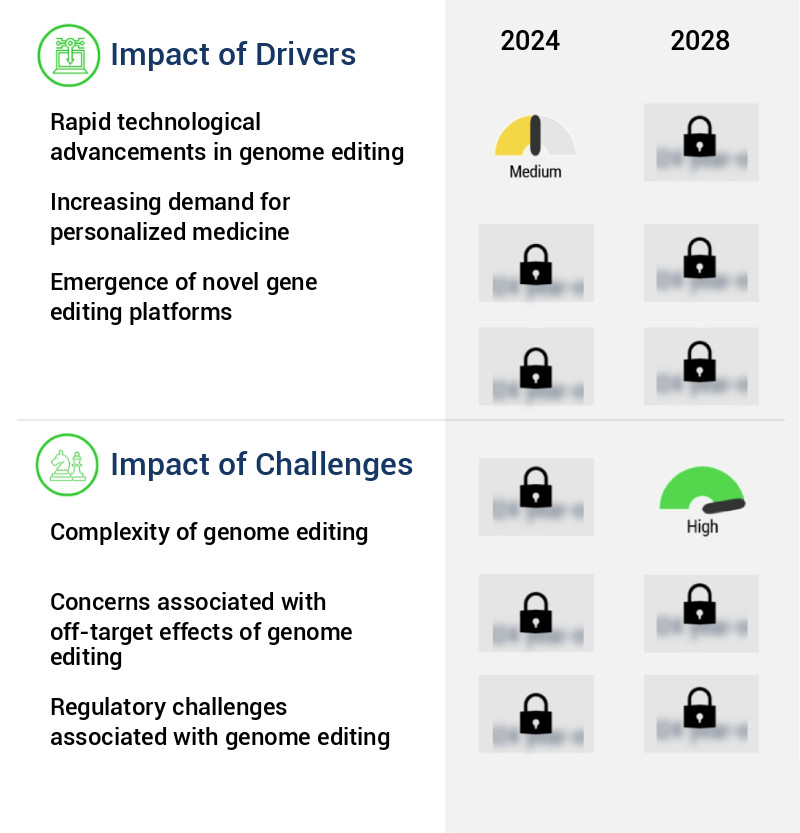
What are the key market drivers leading to the rise in the adoption of Genome Editing Industry?
- The significant advancements in genome editing technology serve as the primary catalyst for market growth.
- Genome editing has seen significant advancements in recent years, driven by the development of precise and efficient tools like CRISPR-Cas9, TALENs, and zinc finger nucleases (ZFNs). These technologies enable researchers to target and modify specific genomic regions with unprecedented accuracy, leading to a multitude of research and therapeutic applications. Beyond traditional gene knockout and insertion techniques, advancements include base editing, prime editing, and epigenome editing, which facilitate more complex modifications such as precise nucleotide changes, gene regulation, and epigenetic modifications.
- High-throughput screening methods have also emerged, allowing researchers to assess the effects of genetic modifications on cellular phenotypes at an accelerated rate. The market is continually evolving, with ongoing research and development efforts expanding the potential applications across various sectors, including agriculture, pharmaceuticals, and synthetic biology. The impact of these advancements on the genome editing landscape is substantial, offering new opportunities for innovation and growth.
What are the market trends shaping the Genome Editing Industry?
- The rise of CRISPR-based diagnostics represents a significant market trend in the field of molecular biology.
CRISPR technology is increasingly being utilized for diagnostic applications due to its precision and efficiency.
- Genome editing, a revolutionary technology, continues to evolve and expand its applications across various sectors. CRISPR-Cas9, a leading genome editing tool, has gained significant traction due to its ease of use and versatility. This technology allows for precise modifications to DNA sequences, opening up possibilities in fields such as agriculture, pharmaceuticals, and research. CRISPR-based diagnostics represent a significant advancement in healthcare, enabling point-of-care testing outside traditional laboratory settings. These decentralized testing solutions offer rapid results, crucial for disease management and containment, particularly in resource-limited settings, remote areas, and during outbreaks or emergencies. CRISPR-based diagnostic platforms, like SHERLOCK and DETECTR, provide high sensitivity and specificity for nucleic acid detection.
- They can accurately identify target sequences at low concentrations, making them invaluable tools for early disease detection and surveillance. Furthermore, these platforms support multiplexing, allowing for the simultaneous detection of multiple targets in a single assay. CRISPR-Cas9's impact extends to agriculture, where it is used for gene editing in crops to improve traits such as resistance to pests, diseases, and environmental stressors. In the pharmaceutical industry, this technology is employed for gene therapy, enabling the correction of genetic mutations responsible for various diseases. Researchers also use genome editing for model organisms, facilitating a deeper understanding of complex biological processes.
- The market is a dynamic and evolving landscape, with ongoing research and development driving innovation and expansion. CRISPR-Cas9's versatility and potential applications continue to unfold, offering significant opportunities for growth and advancements in various sectors.
What challenges does the Genome Editing Industry face during its growth?
- The complexity of genome editing poses a significant challenge to the growth of the industry, requiring advanced scientific knowledge and precise techniques to effectively modify genetic material.
- Genome editing, a revolutionary technology, continues to unfold in various sectors, including research and therapeutic applications. This process involves enhancing the precision of editing tools to maximize genome editing efficiency. CRISPR technologies, known for their simplicity and efficiency, play a significant role in genome editing. However, challenges remain in achieving high specificity and efficiency, particularly for certain editing platforms and target sequences. Genome editing tools, which mediate the insertion or deletion of DNA fragments, rely on the DNA repair mechanism activated by endonucleases like Cas9. Despite advancements, the quality of these tools is yet to be optimized.
- Consequently, targeted alleles may carry additional modifications, such as multiple integrations of target vectors, deletions, and duplications of DNA fragments. Comparatively, the market exhibits continuous growth, with various companies investing in research and development to address these challenges. In recent years, the market has witnessed an increasing number of collaborations and partnerships aimed at improving genome editing technologies. For instance, collaborations between academic institutions and biotech companies have led to significant advancements in CRISPR-Cas9 technology. Moreover, the therapeutic applications of genome editing are gaining momentum, with clinical trials underway for various genetic disorders. The potential of genome editing to cure genetic diseases and improve human health has attracted significant investment from both public and private sectors.
- In 2020, the market was valued at approximately USD6.5 billion and is projected to reach USD28.6 billion by 2026, growing at a steady pace. This growth can be attributed to the increasing demand for personalized medicine, the expanding applications of genome editing in agriculture, and the ongoing research and development efforts in this field. In conclusion, the market continues to evolve, with ongoing research and development efforts aimed at addressing the challenges associated with genome editing tools and realizing the full potential of this technology in research and therapeutic applications. The market's growth is driven by the increasing demand for personalized medicine, the expanding applications of genome editing in agriculture, and the ongoing research and development efforts in this field.
Exclusive Customer Landscape
The genome editing market forecasting report includes the adoption lifecycle of the market, covering from the innovator’s stage to the laggard’s stage. It focuses on adoption rates in different regions based on penetration. Furthermore, the genome editing market report also includes key purchase criteria and drivers of price sensitivity to help companies evaluate and develop their market growth analysis strategies.
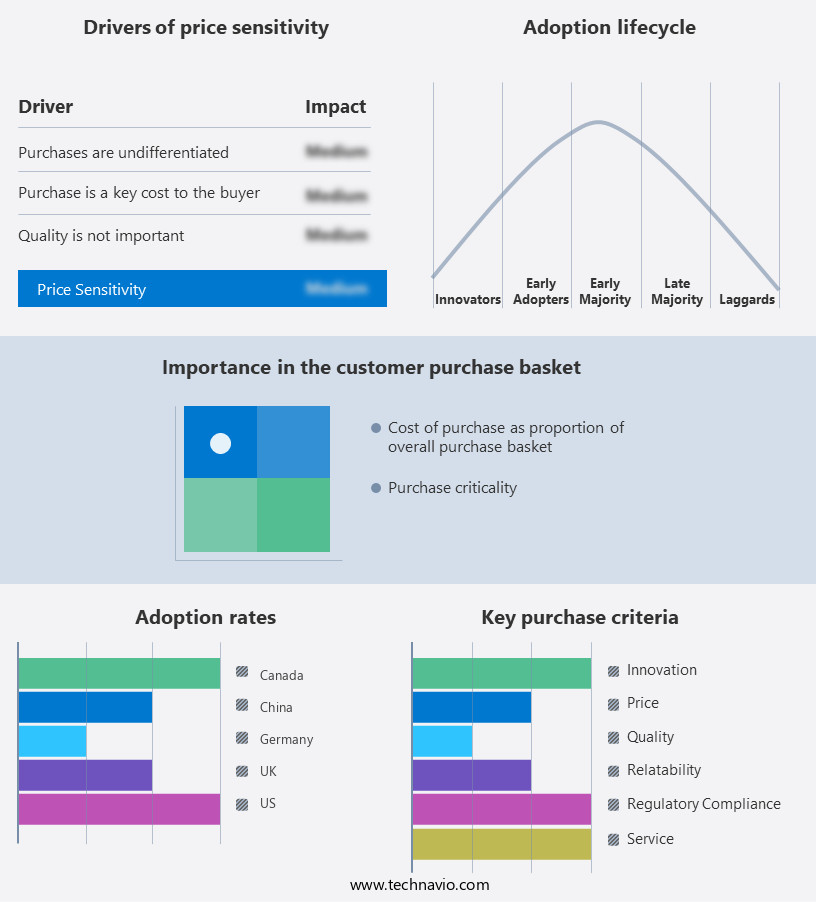
Customer Landscape of Genome Editing Industry
Key Companies & Market Insights
Companies are implementing various strategies, such as strategic alliances, genome editing market forecast, partnerships, mergers and acquisitions, geographical expansion, and product/service launches, to enhance their presence in the industry.
AstraZeneca PLC - Genome editing is a crucial aspect of functional genomics, allowing for the deletion or alteration of genes in cells to elucidate their roles in disease. CRISPR, a widely adopted genome editing tool, facilitates this process through precise DNA modification. As a research analyst, I observe the company's application of advanced genome editing techniques to drive scientific discovery and innovation.
The industry research and growth report includes detailed analyses of the competitive landscape of the market and information about key companies, including:
- AstraZeneca PLC
- Caribou Biosciences Inc.
- Cellectis SA
- Cibus
- Danaher Corp.
- Editas Medicine Inc.
- Egenesis
- GenScript Biotech Corp.
- Horizon Discovery Ltd.
- Intellia Therapeutics Inc.
- Lonza Group Ltd.
- Merck KGaA
- New England Biolabs Inc.
- OriGene Technologies Inc.
- PerkinElmer Inc
- Precision BioSciences Inc.
- Sangamo Therapeutics Inc.
- Takara Bio Inc.
- Tecan Trading AG
- Thermo Fisher Scientific Inc.
Qualitative and quantitative analysis of companies has been conducted to help clients understand the wider business environment as well as the strengths and weaknesses of key industry players. Data is qualitatively analyzed to categorize companies as pure play, category-focused, industry-focused, and diversified; it is quantitatively analyzed to categorize companies as dominant, leading, strong, tentative, and weak.
Recent Development and News in Genome Editing Market
- In January 2024, CRISPR Therapeutics and Vertex Pharmaceuticals announced a strategic collaboration to develop and commercialize gene-editing therapies for genetic diseases, including cystic fibrosis and beta-thalassemia. The partnership combined CRISPR's gene-editing expertise with Vertex's experience in developing and commercializing small molecule therapies (CRISPR Therapeutics Press Release, 2024).
- In March 2024, Editas Medicine received clearance from the U.S. Food and Drug Administration (FDA) to initiate a clinical trial for its gene-editing therapy, designed to treat Leber congenital amaurosis, a rare genetic disease causing blindness. This marked the first FDA approval for a gene-editing therapy to enter human clinical trials (Editas Medicine Press Release, 2024).
- In May 2024, Intellia Therapeutics raised USD300 million in a Series C financing round, led by new investors, including BlackRock and Fidelity Management & Research Company. The funds were earmarked for advancing the company's pipeline of gene-editing therapies, including those for transthyretin amyloid cardiomyopathy and hereditary angioedema (Intellia Therapeutics Press Release, 2024).
- In January 2025, Merck KGaA and CRISPR Therapeutics entered a global strategic collaboration to discover, develop, and commercialize gene-editing therapies for various diseases, including cancer, neurological disorders, and rare genetic diseases. The partnership included an upfront payment of USD1.15 billion to CRISPR Therapeutics (Merck KGaA Press Release, 2025).
Research Analyst Overview
- The market encompasses a diverse range of technologies and applications, with continuous advancements shaping its landscape. One of the most significant developments is the shift towards non-viral delivery methods, which aim to mitigate ethical implications and safety concerns associated with viral vectors. This approach leverages various techniques, including CRISPR-Cas9 system, gene targeting vectors, zfn nucleases, and base editing, to modify DNA sequences without integrating foreign genetic material into the genome. The CRISPR-Cas9 system, a revolutionary gene-editing tool, has gained widespread attention due to its high on-target efficiency and versatility. However, ethical debates persist regarding its use in human applications, necessitating rigorous safety testing and regulatory approvals.
- DNA repair pathways play a crucial role in ensuring the efficacy and specificity of genome editing techniques, with non-homologous end joining and homologous recombination being key pathways. The market's potential extends beyond basic research, with applications in precision medicine, disease modeling, protein production, and genetic modification. For instance, gene knockins, gene expression levels, and gene therapy applications are gaining traction in the pharmaceutical industry as a drug discovery platform. However, off-target effects and transgene integration remain significant challenges that require ongoing research and optimization. Industry growth in the market is expected to reach over 20% annually, driven by the increasing demand for personalized medicine and the potential for novel therapeutic applications.
- This dynamic market continues to evolve, with emerging technologies such as prime editing, site-specific nucleases, and transcriptome analysis shaping its future trajectory.
Dive into Technavio’s robust research methodology, blending expert interviews, extensive data synthesis, and validated models for unparalleled Genome Editing Market insights. See full methodology.
|
Market Scope
|
|
Report Coverage
|
Details
|
|
Page number
|
163
|
|
Base year
|
2023
|
|
Historic period
|
2018-2022 |
|
Forecast period
|
2024-2028
|
|
Growth momentum & CAGR
|
Accelerate at a CAGR of 15.88%
|
|
Market growth 2024-2028
|
USD 7.23 billion
|
|
Market structure
|
Fragmented
|
|
YoY growth 2023-2024(%)
|
14.56
|
|
Key countries
|
US, Canada, UK, Germany, and China
|
|
Competitive landscape
|
Leading Companies, Market Positioning of Companies, Competitive Strategies, and Industry Risks
|
Request Free Sample
What are the Key Data Covered in this Genome Editing Market Research and Growth Report?
- CAGR of the Genome Editing industry during the forecast period
- Detailed information on factors that will drive the growth and forecasting between 2024 and 2028
- Precise estimation of the size of the market and its contribution of the industry in focus to the parent market
- Accurate predictions about upcoming growth and trends and changes in consumer behaviour
- Growth of the market across North America, Europe, Asia, and Rest of World (ROW)
- Thorough analysis of the market’s competitive landscape and detailed information about companies
- Comprehensive analysis of factors that will challenge the genome editing market growth of industry companies
We can help! Our analysts can customize this genome editing market research report to meet your requirements.
Get in touch







![]() Get the report (PDF) sent to your email within minutes.
Get the report (PDF) sent to your email within minutes.
Complimentary full Excel data with your report purchase.